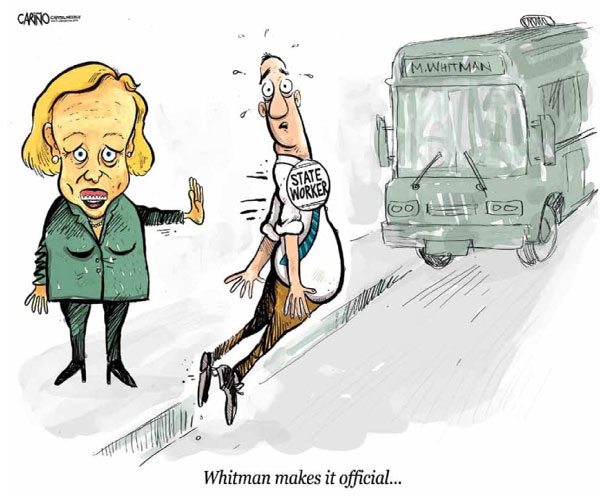Pension initiative cuts benefits, voters can alter
By Ed Mendel
An initiative filed last week would cut pensions for new state and local government hires, but allow local voters to lift the cap.
The initiative sponsors said they will poll voters to see if the pension cuts imposed by the initiative, filed in two versions, should be altered by a majority or a two-thirds vote.
The local option emerged from meetings with groups of city managers in Los Angeles and San Diego counties, said Marcia Fritz, president of the California Foundation for Fiscal Responsibility.
“You can change anything, but you have to have voter approval,” Fritz said. “It’s getting back to square one and getting the voters involved … that removes those closed-door sessions.”
Pension benefits are typically set in labor contract negotiations with public employee unions.
In recent years San Diego and Orange Counties, both hit by increasing pension costs, passed measures that require voters to approve pension benefit increases. San Francisco has a similar century-old requirement.
Local officials want to be able to raise benefits, if need be, to recruit and retain valuable employees. But competition among local governments is said by some to escalate pension benefits.
The initiative aimed at the November ballot next year would make major pension cuts and extend retirement dates for persons hired after June 30, 2011, by the state, cities, counties, school districts, universities and special districts.
“The current system could result in billions of dollars in new taxes to meet the retirement obligations for public employees,” says the initiative. “Many local governments may be threatened with bankruptcy if no change is made.”
The issue of whether the current level of public pension benefits are “sustainable” has been growing, fueled by an historic stock market crash last fall that is expected to force increases in annual government pension payments to replenish retirement funds.
Critics point to a round of benefit increases that began a decade ago when the stock market was booming. Investment earnings, which have been providing 75 percent of the revenue of some pension systems, were expected to pay for the new benefits.
One of the increases allows many police and firefighters to retire at age 50 with 3 percent of their final salary for each year served. The initiative gives new police and firefighters 2.3 percent at age 58.
Many miscellaneous workers can now retire at 55 with 2.5 percent of pay for each year served. The initiative formula is 1.25 percent at age 67 for workers also receiving Social Security, and 1.65 percent if they do not receive Social Security.
Fritz said the basic concept is to make the pensions a “floor” for retirement, supplemented by Social Security and individual investment accounts. Workers could still take early retirement, but their pensions would be reduced.
“I think we are ahead of the world with the policy of working longer,” said Fritz, referring to longer life expectancy. “I think it’s inevitable. I think entire countries are going to go to this — France, Germany.”
Fritz said cutting retirement costs also can “motivate production” by making money available for bonuses and salary increases. She said a recent pension proposal in Southern California would have created a pool of money to reward increased production
The founder of the group now led by Fritz, former Assemblyman Keith Richman, R-Northridge, proposed a plan in 2005 to switch all new state and local government hires to 401(k)-style individual investment plans.
Public employee unions said the proposal would eliminate disability and survivor benefits. A hard-hitting television ad campaign helped cause Gov. Arnold Schwarzenegger to drop his support for the measure.
The Richman group, which said the charge was bogus and even if true easily correctable, is taking no chances this time. The new initiative says death and disability benefits would not be eliminated.
The tax-deferred 401(k) investment plan is now widespread in the private sector, where pensions are rapidly disappearing. The “defined contribution” plans give employers a simple annual payment, creating no decades-long debt for pensions.
But for employees the stock market crash last fall dramatized that 401(k) plans were originally intended to be a supplement, not a basic retirement plan. Persons nearing retirement have little time to rebuild theirinvestment funds.
Fritz, a former 401(k) advocate, now thinks that “defined benefit” pension plans, with their monthly payments guaranteed for life, are a low-cost and efficient way to provide public employee retirement benefits, if properly designed.
“We have a very good system for defined benefit administration and investing already set up,” she said. “I don’t think we should throw it away.”
The foundation led by Fritz filed a similar initiative two years ago, but was unable to gather the voter signatures needed to place the measure on the ballot.
Fritz is looking into whether signatures can be gathered via the Internet. In her last conversation with the secretary of state’s office, she was told that each page of a downloaded petition may have to be signed.
The foundation also plans to seek support from Schwarzenegger and financial backing from two wealthy Republican candidates for governor, Meg Whitman and Steve Poizner.
“I honestly think this is going to be a divisive issue for the governor’s race,” said Fritz.
She said many local government retirement systems will face crash-driven increases in their pension costs next year. The 1,500 local systems in the giant Public Employees Retirement System do not face increases until 2011.
CalPERS has already “smoothed” the local government increases, pushing some costs into the future. No decision has been made about pension costs next year for the state, which faces another massive budget deficit.
Public employee unions are expected to mount a well-funded opposition campaign if the initiative is placed on the ballot.
In a preliminary briefing last week, the board of the California State Teachers Retirement System was told that the initiative would cut the pension of a teacher retiring at age 62 by more than half.
It should be called “The Pension Destruction Act,” said one board member. “The Teacher Poverty Act,” said another.
“There is no question there is a problem,” said Fritz, “and we have a solution. If they stop our solution, then they are the ones that have to be accountable.”
Reporter Ed Mendel covered the Capitol in Sacramento for nearly three decades, most recently for the San Diego Union-Tribune. More stories are at http://calpensions.com/ Posted 10 Nov 09






























